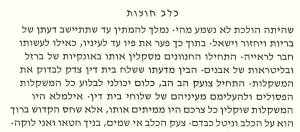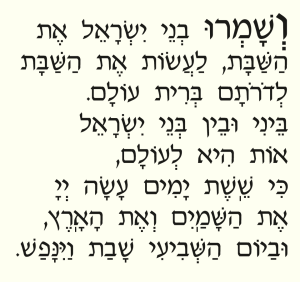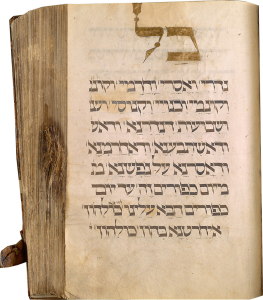I want to begin this post by sharing with you that I have a deep and true love of Mishkan HaNefesh. My congregation used the Reform Movement’s new machzor last year, and as a rabbi and as an individual, I found Mishkan HaNefesh to be inspiring and moving. On Erev Rosh Hashanah, after months of preparation, I stood on the bimah and led my community through our first service with Mishkan HaNefesh. I watched as my congregants encountered and appreciated the beauty of our new machzor. I noticed when they lingered over a prayer that moved them and when they held their books to their chests as they sang words that were so familiar that their books were completely unnecessary. I could see that their hearts were opening to the words and to the experience of praying with Mishkan HaNefesh, and I knew that even as we lived through the inevitable difficulties that that always accompany the first services with any new prayer book, our community had accepted and embraced the opportunity to create new memories with our new prayer books.
Recently, the CCAR Press released Divrei Mishkan HaNefesh: A Guide to the CCAR Machzor. Reading the detailed commentary and the essays included in Divrei reminded me just how much I love Mishkan HaNefesh. Divrei is meant to be a “midrash on the machzor” and offers both very practical advice for using Mishkan HaNefesh as well as high level insight into the book’s creation. There are many, many valuable pieces of information included in Divrei that will undoubtedly enhance the experience and understanding of both congregants and clergy.

Last summer, my congregation was lucky enough to have Rabbi Hara Person, the publisher and director of the CCAR Press, join us for an evening forum about Mishkan HaNefesh. In a couple of hours, Rabbi Person explained to us how Mishkan HaNefesh had come into being while also introducing us to some of the innovative features of the new machzor. This program provided us with invaluable insight into our new prayer books, and as I read Divrei, I felt like I was experiencing an expanded version of Rabbi Person’s wonderful class.
While I found the commentaries at the beginning of Divrei to be enlightening, I thought that the behind-the-scenes information in the essays was really fascinating. I especially enjoyed reading Rabbi Janet R. Marder’s, “Praying in Captivity: Liturgical Innovation in Mishkan HaNefesh,” because she addressed at length my favorite aspect of Mishkan HaNefesh– the beautiful readings and prayers that Rabbi Marder explains are either, “…recovered from the tradition itself… [or] presented in a boldly contemporary idiom.” (p. 72)
 When I sought feedback after the holidays last year, I heard more about the new readings and prayers than any other aspect of our services. I heard over and over again from congregants who looked chagrined as they told me, “I loved the readings so much! Sometimes I wouldn’t follow along with the service because I wanted to stay on a page that really spoke to me.” When I replied that I thought it was wonderful that they had connected so deeply with the prayer book, they immediately grew animated as they shared exactly which texts had affected them. More often than not, the readings that grabbed their attention are what Rabbi Marder calls “counter-texts.” (p. 72) For my congregants and myself, these counter-texts and their relationships to the canonical prayers were and continue to be incredibly powerful.
When I sought feedback after the holidays last year, I heard more about the new readings and prayers than any other aspect of our services. I heard over and over again from congregants who looked chagrined as they told me, “I loved the readings so much! Sometimes I wouldn’t follow along with the service because I wanted to stay on a page that really spoke to me.” When I replied that I thought it was wonderful that they had connected so deeply with the prayer book, they immediately grew animated as they shared exactly which texts had affected them. More often than not, the readings that grabbed their attention are what Rabbi Marder calls “counter-texts.” (p. 72) For my congregants and myself, these counter-texts and their relationships to the canonical prayers were and continue to be incredibly powerful.
As I prepared for the High Holy Days last year, I spent hours reading both volumes of Mishkan HaNefesh like novels– approaching each page with a pencil in hand, filling the margins with notes about how I felt about each text, and drawing stars next to my favorite readings (full disclosure- there were a lot of stars). 
Early on in my preparation, I decided to share my enjoyment of Mishkan HaNefesh through social media. My posts and tweets helped create a sense of anticipation and excitement in my community and let my congregants know how deeply I connected with our new machzor.
As I prepare for my second High Holy Days with Mishkan HaNefesh, I find myself eagerly anticipating the choice of which prayers and readings I’ll include in this year’s services. I’m looking forward to incorporating what I have learned from both last year’s High Holy Days as well as the resources included in Divrei as I seek to create and lead meaningful services for my community. And, when the choices seems too difficult, I’m going to comfort myself with what I think is one of the most important messages in Divrei Mishkan HaNefesh– namely that, “…what matters is not ‘mastering’ the book, but rather allowing the book to help us experience transformative, sacred moments.” (p. 2)
—
Rabbi Rachel Bearman serves Temple B’nai Chaim in Georgetown, Connecticut.







 invest in their own copy. Many pre-purchased the book and we provided personalized bookplates. We had a number of copies for congregants to borrow and on Rosh HaShanah, all of the books had a card inside. I invited the congregation once again to purchase their own copy. I asked them to fill out the card that evening, give it to a greeter, and then take the book home. The next week, we had the Yom Kippur edition and
invest in their own copy. Many pre-purchased the book and we provided personalized bookplates. We had a number of copies for congregants to borrow and on Rosh HaShanah, all of the books had a card inside. I invited the congregation once again to purchase their own copy. I asked them to fill out the card that evening, give it to a greeter, and then take the book home. The next week, we had the Yom Kippur edition and 
















